| Author |
Message |
|
S Wilkins
|
 Posted: Fri 28 Jan, 2005 9:14 pm Post subject: rust removal/prevention Posted: Fri 28 Jan, 2005 9:14 pm Post subject: rust removal/prevention |
 |
|
I own a del tin Scottish Claymore purchased through Albion [url]http://albion-swords.com/swords/deltin/sword-dt5151.htm. [/url] I recently noticed a bit of rust on the pommel, hilt, and a little dot on the blade. Does anyone have suggestions for removal of the aforementioned rust without detriment to the integrity of the blade?
Also, any suggestions as to types of oils that are best for preventative measures against rust, "tha wee deil," would be greatly appreciated.
Tapah Leibh,
S. Wilkins
|
|
  |
 |
Alexi Goranov
myArmoury Alumni


|
 Posted: Fri 28 Jan, 2005 9:21 pm Post subject: Re: rust removal/prevention Posted: Fri 28 Jan, 2005 9:21 pm Post subject: Re: rust removal/prevention |
 |
|
| S Wilkins wrote: | I own a del tin Scottish Claymore purchased through Albion [url]http://albion-swords.com/swords/deltin/sword-dt5151.htm. [/url] I recently noticed a bit of rust on the pommel, hilt, and a little dot on the blade. Does anyone have suggestions for removal of the aforementioned rust without detriment to the integrity of the blade?
Also, any suggestions as to types of oils that are best for preventative measures against rust, "tha wee deil," would be greatly appreciated.
Tapah Leibh,
S. Wilkins |
Read this thread for ideas and suggestions.
But to quote another fellow froumite "Embrace the Rust". I am currently soaking the pommel of my Albion NG duke in acetic acid and salt...Yep I am purposefully rusting an Albion sword........Yes I have had a CAT scan recently. 
Alexi
|
|
  |
 |
Nathan Robinson
myArmoury Admin


|
|
    |
 |
Steve Grisetti

|
 Posted: Sat 29 Jan, 2005 5:01 am Post subject: Re: rust removal/prevention Posted: Sat 29 Jan, 2005 5:01 am Post subject: Re: rust removal/prevention |
 |
|
| Alexi Goranov wrote: |
I am currently soaking the pommel of my Albion NG duke in acetic acid and salt...Yep I am purposefully rusting an Albion sword........Yes I have had a CAT scan recently. 
Alexi |
Alexi - As I note your signature block, I must wonder if you are attempting to apply "logic" in this case. Rust! Arrggh!
|
|
  |
 |
|
S Wilkins
|
 Posted: Sun 30 Jan, 2005 12:26 pm Post subject: thanks Posted: Sun 30 Jan, 2005 12:26 pm Post subject: thanks |
 |
|
Thank You all for your posts. Though I am not yet willing to embrace the rust ( I shall vanquish it). Thank you Nathan for the article, guess I should have browsed the site a little more before posting. I am going to buy the steel wool, oil, and compound tomorrow.
Thanks ,
S Wilkins
|
|
  |
 |
Sean Flynt

|
|
   |
 |
Alexi Goranov
myArmoury Alumni


|
 Posted: Mon 31 Jan, 2005 2:11 pm Post subject: Posted: Mon 31 Jan, 2005 2:11 pm Post subject: |
 |
|
| Sean Flynt wrote: | | Alexi: I can't wait to see the results of your antiquing experiment. I suspect Peter and the Albion folks will be very interested as well. |
Once I obtain results worth showing  So far I am only messing around with the pommel. If I am happy with the results I may also play around with the guard. I am not planning on aging the blade, as it will slowly darken by itself albeit in a longer period of time. I am trying to mimic the effects of weather exposure of the hilt, since the blade would have been protected more or less by the scabbard. So far I am only messing around with the pommel. If I am happy with the results I may also play around with the guard. I am not planning on aging the blade, as it will slowly darken by itself albeit in a longer period of time. I am trying to mimic the effects of weather exposure of the hilt, since the blade would have been protected more or less by the scabbard.
I have to say that rusting is much harder than one might imagine. Rust is so darn easy to remove  ..........In previous attempts it took me about a week of applying acetic acid and salt to get the level of patination I desired. I have the "campaign worn" grip on the Albion sword so I hope it will look somewhat decent after my futile attempts. ..........In previous attempts it took me about a week of applying acetic acid and salt to get the level of patination I desired. I have the "campaign worn" grip on the Albion sword so I hope it will look somewhat decent after my futile attempts.
Alexi
|
|
  |
 |
Sean Flynt

|
|
   |
 |
Jean Thibodeau

|
 Posted: Mon 31 Jan, 2005 3:39 pm Post subject: Posted: Mon 31 Jan, 2005 3:39 pm Post subject: |
 |
|
Alexi;
Try lemon juice soaked toilet paper that you leave in contact with the steel for 6 to 12 hours and you should get a grayish patina. Worked for me, I mentioned this on the Kern axe thread by Sean a while back.
If there is a pattern on the toilet paper you can get a partial transfer of this pattern on the steel.
The process seemed quite fast and doesn't look like rust but more like a patina: Oiling and rubbing away more or less of it and or repeating the process can give you a more or less dark slightly pited and etched finish.
I always recommend trying this on a piece of scrap steel first.
This is the lemon juice you buy in those plastic lemons to use on fish.
You can easily give up your freedom. You have to fight hard to get it back!
|
|
  |
 |
Alexi Goranov
myArmoury Alumni


|
 Posted: Mon 31 Jan, 2005 4:09 pm Post subject: Posted: Mon 31 Jan, 2005 4:09 pm Post subject: |
 |
|
| Jean Thibodeau wrote: | Alexi;
Try lemon juice soaked toilet paper that you leave in contact with the steel for 6 to 12 hours and you should get a grayish patina. Worked for me, I mentioned this on the Kern axe thread by Sean a while back.
If there is a pattern on the toilet paper you can get a partial transfer of this pattern on the steel.
The process seemed quite fast and doesn't look like rust but more like a patina: Oiling and rubbing away more or less of it and or repeating the process can give you a more or less dark slightly pited and etched finish.
I always recommend trying this on a piece of scrap steel first.
This is the lemon juice you buy in those plastic lemons to use on fish. |
That is exactly what I have done except I used acetic acid and paper towels. I did get the pattern transferred, but did not like the results. The darkening (more greyish dull color) does happen relatively fast , but I am looking for a darker color and that takes more time (few days). I also have found that the spray method (the one described by Sean in his article) gives faster and gives slightly more "natural" results, at lest in my opinion. However I keep using the wetted towel method since it is easier to contain and do inside an apartment.
It might be worth trying the lemon juice.
I am afraid we turned this thread from how to prevent rust into how to rust stuff..........
Alexi
|
|
  |
 |
Jean Thibodeau

|
 Posted: Mon 31 Jan, 2005 4:30 pm Post subject: Posted: Mon 31 Jan, 2005 4:30 pm Post subject: |
 |
|
Alexi;
Yes,we do seem to alway highjack threads ....... LOL.
Just had a quick look at my Albion francisca that got the lemon treatment after I had polished it bright, and the finish is very dark: On a scale of 1 to 10 with 10 being black I would call it a 7 or 8 so it did turn out fairly dark.
The pattern if repeated a few times becomes more random: It helps if you like the pattern of the toilet paper, it does look a bit like patterned steel.
Anyway if you do try the lemon juice I would like to know how it differs in results from the chemical treatment you used.
(Just curious!)
Just to be open minded I should try Sean method on my next project.
You can easily give up your freedom. You have to fight hard to get it back!
|
|
  |
 |
Alexi Goranov
myArmoury Alumni


|
 Posted: Fri 04 Feb, 2005 5:31 pm Post subject: Posted: Fri 04 Feb, 2005 5:31 pm Post subject: |
 |
|
| Sean Flynt wrote: | | Alexi: I can't wait to see the results of your antiquing experiment. I suspect Peter and the Albion folks will be very interested as well. |
Well here are few shots. It has not gotten yet to where I want it to be, but patience ...and more acid will do.
Alexi
 Attachment: 71.52 KB Attachment: 71.52 KB
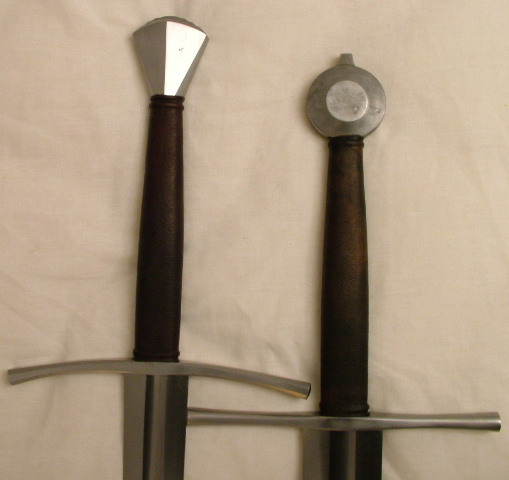
 Attachment: 63.79 KB Attachment: 63.79 KB
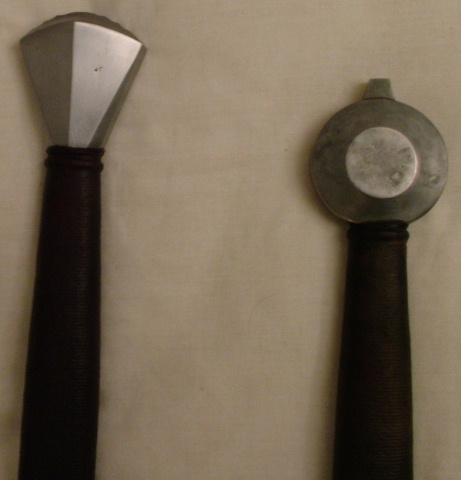
 Attachment: 87.89 KB Attachment: 87.89 KB
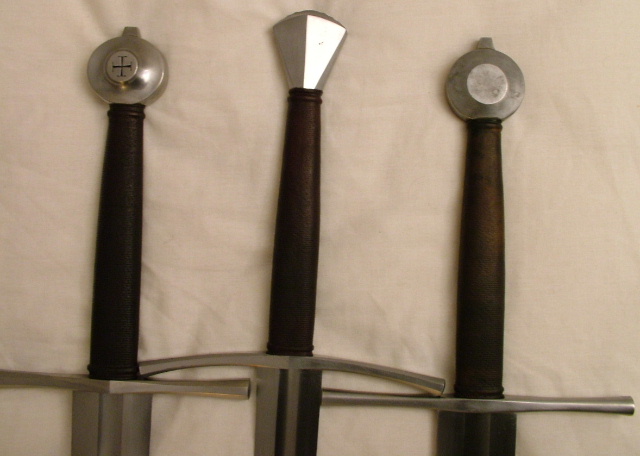
 Attachment: 60.38 KB Attachment: 60.38 KB
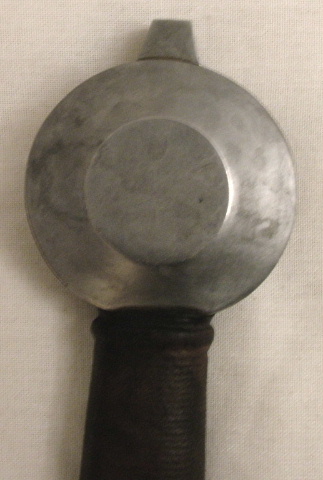
|
|
  |
 |
Alexi Goranov
myArmoury Alumni


|
 Posted: Tue 08 Feb, 2005 7:45 pm Post subject: Posted: Tue 08 Feb, 2005 7:45 pm Post subject: |
 |
|
| Jean Thibodeau wrote: | Alexi;
Try lemon juice soaked toilet paper that you leave in contact with the steel for 6 to 12 hours and you should get a grayish patina. Worked for me, I mentioned this on the Kern axe thread by Sean a while back.
|
Just a little bit of trivia that does not get discussed a lot. Not all steels are created equal, meaning different steels have different properties. One of these properties is the way steels rust (how fast, what color).
I did the little "lemon juice" experiment by putting few drops of concentrated lemon juice on the pommel of my Duke and on the blade of an MRL sword. The results were very different. The MRL sword developed very dark, blackish spots within 10-20min. The pommel of the duke was basically unaffected (as compared to how it was before, see pictures above) even after 24h.
So the bottom line: when "aging" stuff the results will vary from sword to sword and from component to component (hilt components that is) so much patience would be a valuable asset.
Alexi
|
|
  |
 |
Jean Thibodeau

|
 Posted: Tue 08 Feb, 2005 8:10 pm Post subject: Posted: Tue 08 Feb, 2005 8:10 pm Post subject: |
 |
|
Alexi;
I used the lemon juice on an Albion francisca, a cold steel Larado Bowie, two A&A spears, a cold steel Gurka kukri with similar results.
Lemon juice was kept in contact with the metal by the soaked toilet paper, in some cases I may have re- wetted the toilet paper with fresh juice a couple of times before letting the whole thing dry out.
So the lemon juice did get a good chance to attack the metal before evaporating or flowing off the surface.
I haven't tried it on my two Albion swords so I can't tell you if doing it exactly the same way would have the same results on the steel used.
Just detailling a bit more the way I used the lemon juice in case it might be usefull.
Oh, appart from how the juice acted differently on different steels, did the results / color / pitting etc... appeal to you: Just curious ? How different are the results from using the salt water / vinigar mix?
You can easily give up your freedom. You have to fight hard to get it back!
|
|
  |
 |
Alexi Goranov
myArmoury Alumni


|
 Posted: Sun 13 Feb, 2005 7:52 am Post subject: Posted: Sun 13 Feb, 2005 7:52 am Post subject: |
 |
|
Hi Jean,
I got the "lemon juice" method to work with great success. The trick was to mix it with water so that the juice is not as sticky and thick, then wet the paper towel and apply to the component to be rusted. It worked much better then the vinegar/salt combination. I think that the vinegar I was using was too low on acetic acid.
It is still worth noting that different steels rusted differently. My A&A dagger rusted black, but the Duke's pommel rusted reddish/brown and a little bit slower. The peen of the duke though rusted black, which suggests that the blade would also rust black if I were crazy enough to attempt to "age" it. I am not that crazy......yet.
Pictures coming soon.
Alexi
|
|
  |
 |
|
Peter Johnsson
Industry Professional
|
 Posted: Sun 13 Feb, 2005 9:06 am Post subject: Posted: Sun 13 Feb, 2005 9:06 am Post subject: |
 |
|
| Alexi Goranov wrote: | Hi Jean,
I got the "lemon juice" method to work with great success. The trick was to mix it with water so that the juice is not as sticky and thick, then wet the paper towel and apply to the component to be rusted. It worked much better then the vinegar/salt combination. I think that the vinegar I was using was too low on acetic acid.
It is still worth noting that different steels rusted differently. My A&A dagger rusted black, but the Duke's pommel rusted reddish/brown and a little bit slower. The peen of the duke though rusted black, which suggests that the blade would also rust black if I were crazy enough to attempt to "age" it. I am not that crazy......yet.
Pictures coming soon.
Alexi |
Yes!
Embrace the rust!
I really think you should go deeper in your "madness" 
Looks very promising to me.
This is something IŽd like to explore more myself, so please keep posting the results of your exeriment 
|
|
   |
 |
Steve Maly

|
 Posted: Sun 13 Feb, 2005 9:37 am Post subject: Posted: Sun 13 Feb, 2005 9:37 am Post subject: |
 |
|
| Alexi Goranov wrote: |
It is still worth noting that different steels rusted differently. My A&A dagger rusted black, but the Duke's pommel rusted reddish/brown and a little bit slower. The peen of the duke though rusted black, which suggests that the blade would also rust black if I were crazy enough to attempt to "age" it. I am not that crazy......yet.
Pictures coming soon.
Alexi |
Yes, Alexi, I've noticed the same thing too. When I antiqued my DT2153 (Chrome-Vanadium steel) using the "salt & vinegar" technique, it turned dark gray and developed the splotches I wanted within a day or two (pics are in my album on this site). I am currently antiquing my Albion Gaddhjalt (1075 steel) and the bugger is taking forever to age--especially the hilt. I've been working on it since before Christmas. The blade turned gray and developed some "spots" (I'm assuming from the salt crystals concentrating in small areas) pretty quickly, but when I rubbed off the brown rust, the hilt still looked bright and shiny! I've been alternately giving the blade a good cleaning with to check progress towards the look I want, but I've just left the hilt alone to "cook" more. I want it to look like an antique, not just "neglected"! 
"When the only tool you own is a hammer, every problem begins to resemble a nail." ~A. Maslow
|
|
   |
 |
Alexi Goranov
myArmoury Alumni


|
 Posted: Sun 13 Feb, 2005 7:11 pm Post subject: Posted: Sun 13 Feb, 2005 7:11 pm Post subject: |
 |
|
Here is what the pommel looked after 3 days of lemon juice. This is before cleaning the lose rust off. I do not think I will stop here as the pattern is not random and "natural" enough. For a comparison : a clean Albion pommel from the NG Baron.
Alexi
 Attachment: 32.89 KB Attachment: 32.89 KB
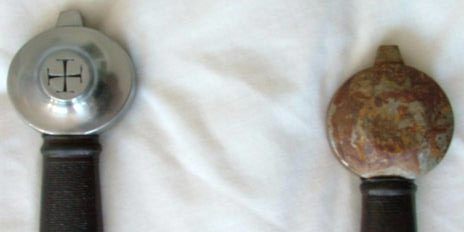
|
|
  |
 |
Alexi Goranov
myArmoury Alumni


|
 Posted: Fri 18 Feb, 2005 8:57 pm Post subject: Posted: Fri 18 Feb, 2005 8:57 pm Post subject: |
 |
|
Here is the "after" shot. I also rusted the guard. I kind of like the contrast between the darker hilt componets and the bright blade. Lemon juice is the "bomb". Sorry for the lights. If I had better lighting, I could take more detailed shots to show the patination more clearly.
Just remember: acid rusts, metal but also removes rust easily.....so annoying sometimes.
Alexi
 Attachment: 65.04 KB Attachment: 65.04 KB
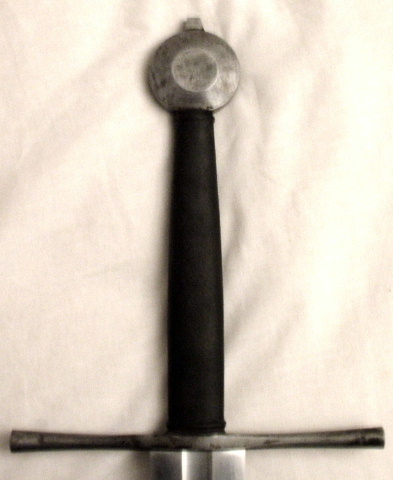
 Attachment: 55.39 KB Attachment: 55.39 KB
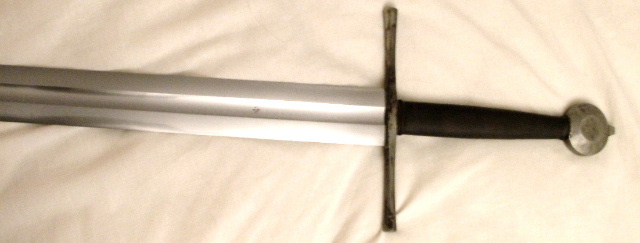
 Attachment: 105.65 KB Attachment: 105.65 KB
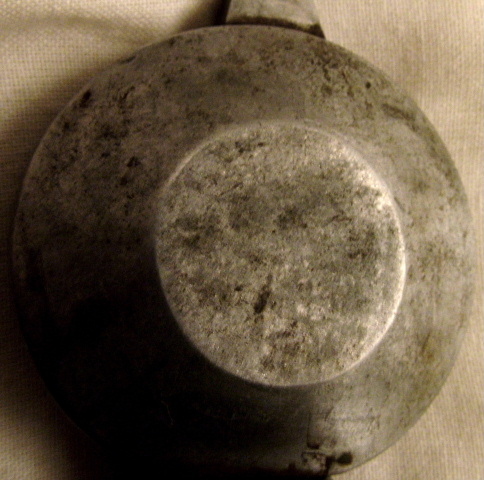
|
|
  |
 |
Stephen A. Fisher

Location: Kentucky USA Joined: 17 Oct 2003
Posts: 455
|
 Posted: Fri 18 Feb, 2005 9:20 pm Post subject: Posted: Fri 18 Feb, 2005 9:20 pm Post subject: |
 |
|
Hey Alexi,
Poor Albion Duke.  Seriously, It looks great. I like the contrast as well. Although, I think the blade would look great if was given the same treatment as Seans MRL Falchion. It will give it the 'Could care less if the hilt is rusting, need to keep the blade clean look.' Seriously, It looks great. I like the contrast as well. Although, I think the blade would look great if was given the same treatment as Seans MRL Falchion. It will give it the 'Could care less if the hilt is rusting, need to keep the blade clean look.'
(pictured in the middle)
 Attachment: 53.67 KB Attachment: 53.67 KB

|
|
   |
 |
|
|

